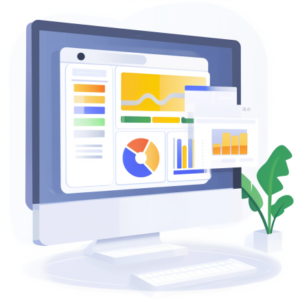Google analytics 4 – GA4 is one of the most powerful tools for data tracking. There are 30+ million websites that using ga4!
So you just can not ignore the power of ga4 in 2024.
In this article we will discuss the overview and sections of google analytics step by step for your business. Stay tuned.
Overview of Google Analytics
What is GA4?
GA4 is the latest iteration of Google’s analytics platform, designed to give businesses deeper insights into their user behavior and interactions across various digital platforms. Unlike the previous version, Universal Analytics (UA), GA4 focuses on a more holistic approach to tracking and analyzing user activity.
Why Upgrade to GA4?
The transition to GA4 offers several benefits. First, it provides a more integrated view of user interactions across both websites and apps. Second, it uses machine learning to predict user behavior and outcomes, helping businesses make data-driven decisions. Lastly, it aligns with evolving privacy regulations, offering improved data management and user consent features.
Key Features of GA4
Event-Based Tracking
One of the standout features of GA4 is its event-based tracking system. Unlike Universal Analytics, which relies heavily on page views and sessions, GA4 focuses on events. This approach allows for more granular data collection and a deeper understanding of user interactions.
Enhanced Measurement
GA4’s enhanced measurement capabilities automatically track a variety of events without requiring additional code. This means you get more data out of the box, including scrolls, outbound clicks, site searches, and video engagement, which enriches your understanding of user behavior.
AI-Powered Insights
With built-in machine learning, GA4 can provide predictive metrics and insights. This includes forecasts about user churn and potential revenue, helping businesses anticipate future trends and adjust their strategies accordingly.
User-Centric Reporting
GA4’s reporting is designed to be more user-centric, focusing on individual user journeys rather than aggregate data. This approach helps businesses understand how users interact with their content over time, providing a more nuanced view of user engagement.
Comparing GA4 to Universal Analytics
Data Collection
GA4’s event-based model represents a significant shift from the session-based model of Universal Analytics. This change allows for more detailed tracking of user interactions and provides a better understanding of the user journey.
Reporting Interface
The reporting interface in GA4 is more streamlined and customizable compared to Universal Analytics. It emphasizes real-time data and predictive insights, giving users the flexibility to create reports that align with their specific business needs.
User Privacy and Data Management
In response to increasing privacy concerns, GA4 includes enhanced features for data management and user privacy. This includes better controls for user consent and more robust data deletion options, helping businesses comply with regulations like GDPR and CCPA.
log in to analytics account
Log in to your analytics property. You will see a dashboard like this
First you need to set up your dashboard in a proper way. Hover into the Libray section and choose your dashboard type as you want.
choose your collection type
You can see multiple options there, select your collection type and publish to all
- Report snapshot
In the report snapshot section you can see the overall scenario of your property.
- User in the last 30 minutes
- User number
- New user
- Average engagement time etc
2. Real time
In the real time section you can see the users who are navigating your website.
- Number of users
- From which Country
- Amount of time length
- From which sources
- From which medium
- Audience type
- Key events
3. Life Cycle
- In Acquisition overview you can monitor your user vs new user report, from which channel they came form and so on
- In Engagement overview you can monitor average engagement time, session, events data, pages etc
- In Retention overview you can monitor your retained user vs new user along with other tracking
Along with the above you can track the organic reports also
Common Challenges and Solutions
Handling Data Accuracy Issues
One common challenge with GA4 is ensuring data accuracy. This can be addressed by regularly auditing your tracking setup and verifying that all events and conversions are being captured correctly.
Dealing with Learning Curves
GA4’s new features and reporting interface can present a learning curve for users accustomed to Universal Analytics. Investing time in training and exploring GA4’s documentation can help overcome these challenges.
Future Trends and Updates
Evolving Features
GA4 is continuously evolving, with Google regularly adding new features and enhancements. Staying informed about these updates ensures you can leverage the latest tools and capabilities.
FAQs
1. What is the main advantage of GA4 over Universal Analytics?
The main advantage of GA4 is its event-based tracking model, which offers more detailed and flexible insights into user behavior compared to the session-based model of Universal Analytics.
2. Can I use GA4 alongside Universal Analytics?
Yes, you can use GA4 alongside Universal Analytics. This approach allows you to gradually transition to GA4 while still benefiting from the data collected by Universal Analytics.
3. How often should I review my GA4 data?
It’s advisable to review your GA4 data regularly, such as weekly or monthly, to stay updated on user behavior trends and make informed decisions based on the latest insights.
4. Is GA4 suitable for eCommerce tracking?
Yes, GA4 is well-suited for eCommerce tracking. It provides detailed reports on user interactions, transactions, and revenue, helping businesses optimize their eCommerce strategies.




